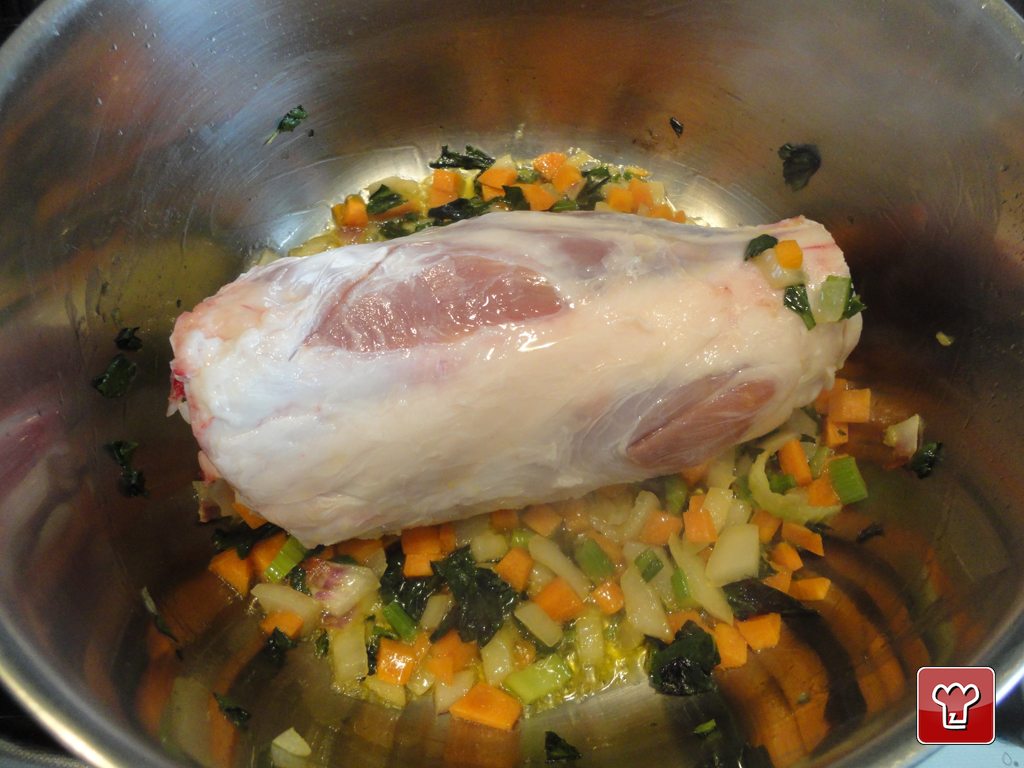Roast pork shank
Roast pork shank with potatoes is a very substantial and tasty main dish made with a joint of pork which is browned in a frying pan first and then cooked in the oven with the potatoes. Much of the flavour in this dish is provided by the chopped onion, carrot and celery and the delicate but decided rosemary and sage notes. This main course is suitable for many different occasions: it can be made a s part of a large dinner party with friends or relatives, it’s perfect for the festive season, or it can be the main dish for a simple family dinner. Whatever the occasion get ready to be impressed! Making this dish is straightforward but the result is truly remarkable, and you will only need to follow a few essential tips to make it a great success. So let's work together to make this delicious dish: putting it together will be even easier if you follow the photo gallery carefully and the accompanying descriptions.
Ingredients

Send the recipe
Preparation
Chop the onion, carrots and celery and fry briefly in 4 tablespoons of oil, then add the pork shank. Brown it well on both sides, then add the coarsely chopped rosemary and sage. Pour in the red wine and cook over high heat until the alcohol evaporates. Peel the potatoes, cut them into large pieces and place in a baking dish. Drizzle with the remaining oil and the salt, add the pork shank to the centre of the dish and cook everything at 200°C for about an hour in the oven. Serve immediately.
Step by step
|
View the step by step

|
Add the herbs
|
|
View the step by step
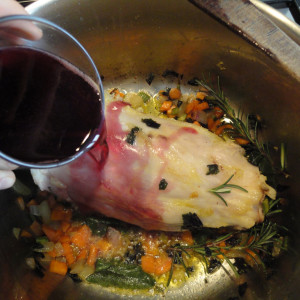
|
Reduce the red wine
|
|
View the step by step

|
Leave the shank to cook in its cooking juices
|
|
View the step by step
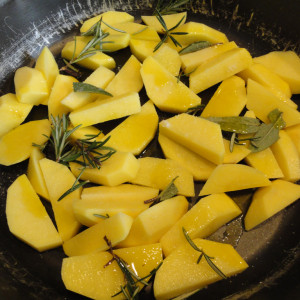
|
Cut the potatoes into chunky pieces and season
|
|
View the step by step
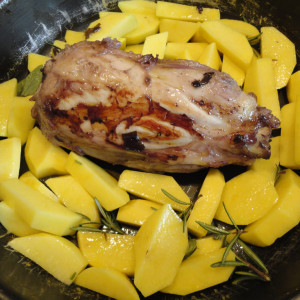
|
Place the shank in the centre of the potatoes and roast
|
|
View the step by step
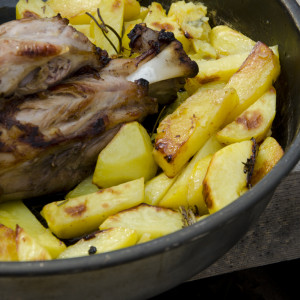
|
Serve
|
Additional Information
Roast shank of pork cooking time
When it comes to preparing a succulent roast shank of pork, timing is crucial. Determining the optimal pork shank cooking time can make or break your dish. So, how long to roast shank of pork? This question is pivotal for achieving that perfect balance of tenderness and flavor. Typically, a pork shank requires a slow and steady roast to allow the meat to become tender while developing a rich, caramelized exterior. Therefore, it's essential to plan ahead and allocate ample time for the cooking process. Generally, a pork shank will require around 2-3 hours in the oven at a moderate temperature, but this can vary depending on the size of the shank and individual preferences. Monitoring the internal temperature with a meat thermometer is advisable to ensure it reaches the desired doneness. So, remember, mastering the pork shank cooking time is the key to a delectable dish that will have everyone coming back for more.
Roast Leg of Pork in Slow Cooker
Preparing a mouthwatering roast leg of pork in a slow cooker offers convenience without sacrificing flavor. While the traditional method often involves a slow roast shank of pork in the oven, opting for the slow cooker presents an alternative that yields equally delicious results. Unlike the rapid cooking process of a roast leg of pork in an air fryer, the slow cooker method allows the flavors to meld together gradually, resulting in tender, juicy meat that practically falls off the bone. However, for those seeking a quicker cooking time and a crispy exterior, cooking the roast leg of pork in an air fryer offers an enticing option worth exploring. So, if time is of the essence and a crunchy texture is desired, the air fryer might just be your ticket to a delightful roast leg of pork.
Roast leg of pork bone in and boneless
When it comes to mastering the art of a delectable roast leg of pork recipe, one must consider various factors, including the choice between bone-in and boneless cuts. Both variations offer unique advantages and challenges, shaping the overall cooking experience. Understanding the optimal roast leg of pork temperature is essential, regardless of whether you opt for bone-in or boneless. Achieving the perfect balance between a golden-brown crust and succulent meat requires careful monitoring of the roast leg of pork internal temperature throughout the cooking process. While some prefer the traditional method of roasting shank of pork in the oven, others may explore alternative techniques such as grilling or slow cooking. Regardless of the chosen method, mastering the roast leg of pork recipe ensures a memorable dining experience for all.
What is pork shank?
Pork shank refers to the lower portion of the pig's leg, typically cut from the area just above the ankle joint. It contains a significant amount of connective tissue and collagen, which contribute to its rich flavor and tender texture when cooked properly.
Is pork shank good to eat?
Yes, pork shank is indeed good to eat. When cooked slowly and properly, it becomes tender and flavorful, making it a delicious addition to various dishes such as stews, braises, and roasts.
Is pork shank fatty?
Pork shank does contain some fat, but it is not excessively fatty compared to other cuts of pork. The fat content contributes to the flavor and juiciness of the meat when cooked.
What is the difference between ham hock and pork shank?
The main difference between ham hock and pork shank lies in their location on the pig's leg and their culinary uses. Ham hock comes from the area closer to the pig's foot and contains more collagen, making it ideal for adding flavor and richness to soups, stews, and beans. Pork shank, on the other hand, is cut from higher up on the leg and has a meatier texture, often used for roasting or braising whole.




